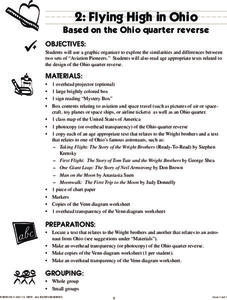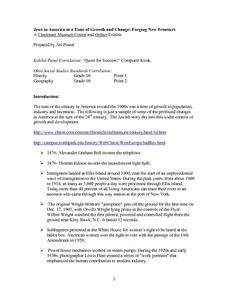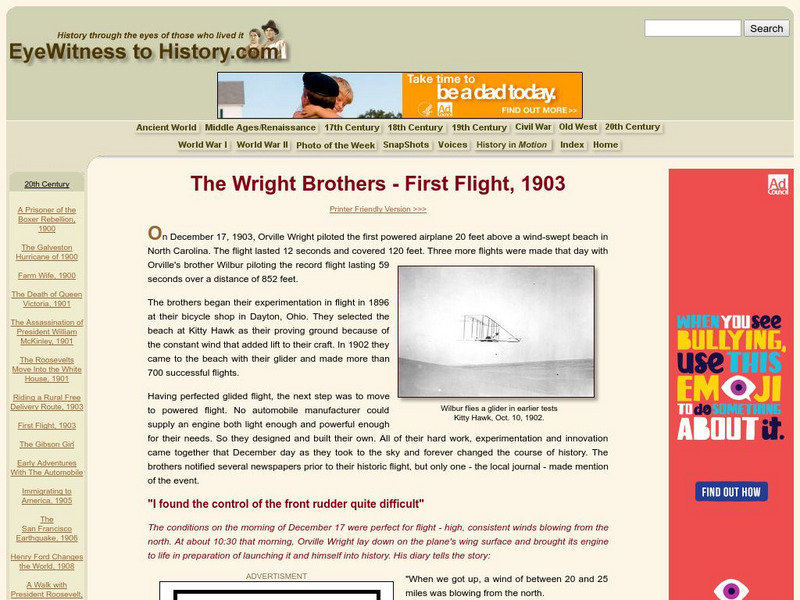Teach Engineering
You Are There... First Flight
Glide into the study of flight. An engaging lesson has scholars research information on the Wright brothers. They develop props and produce a recreation of the first flight at Kitty Hawk. They then report on the event as if they were...
Curated OER
A Life Without Flight
Students explore impact of Ohio's aviation pioneers on life in America, discuss what life today would be like without people like the Wright Brothers, John Glenn, and Neil Armstrong, and brainstorm and research list of items that space...
Curated OER
Flying High in Ohio
Her is a lesson using the Ohio State Quarter. Pupils utilize beautifully-designed worksheets embedded in the plan, to study about the origins of aviation. Many of the pioneers of aviation were born in Ohio. They compare some of the...
Curated OER
Celebrating A Century of Flight
Students investigate the Wright Brothers. They complete an online Webquest, explore various websites, use a flight simulator, answer discussion questions, and locate newspaper articles on the 100th anniversary of the Wright brothers'...
Curated OER
Stories of the Wrights' Flights
Students examine primary sources to understand the work of Wright Brothers. In this aviation history lesson, students study how primary documents and images are analyzed and write essays about the signifcance of primary soures in...
Curated OER
Stories of the Wrights' Flight
Students examine and compare primary and secondary source accounts of the Wright brothers' first flights on December 17, 1903.
Curated OER
Wright Brothers Centennial: North Carolina, Geography and History
Fourth graders identify symbols, people and events associated with North Carolina history. Using this information, they focus on the Wright brothers and their first flight. They answer questions related to the event and discuss how...
Curated OER
Flying With The Wright Stuff
Students explore the history of flight, specifically the Wright brothers. Pupils create paper airplanes. They discuss considerations in building an aircraft such as drag, thrust, and weight. Classmates compare the Wright Brother's...
Curated OER
Wright Brothers Centennial: North Carolina, Creation and Development of the State
Eighth graders examine technological advances and how they influenced the quality of life in North Carolina. Using maps, they locate the city of Kitty Hawk and discuss why it was chosen for the first flight. They read primary source...
Curated OER
Wright Brothers Centennial: Impact of Technological Advance
Eighth graders examine the impact of powered flight on the North Carolina coast. After reading news articles, they explain how the first flight affected community pride. They develop a hypothesis about the long-term economic impacts to...
Curated OER
Aviation Pioneers
Students research the Wright Brothers historic first flight and design a travel poster asking for volunteers to participate. Write a newspaper account of the first flight and include how the local people may have felt about the Wright...
Curated OER
Flying High in Ohio
Students use a Venn diagram to explore the similarities and differences between two sets of "Aviation Pioneers." They read age appropriate texts related to the design of the Ohio quarter reverse. They examine the quarter and locate Ohio...
Curated OER
Jews in America at the Time of Growth and Change: Forging New Frontiers
Tenth graders examine the role of Jewish Americans in the 1900s. They examing the changes in industry and inventions. They also identify how Jewish Americans changed society and religious organization.
Joy Uzarraga
Famous American Research Project
Designed specifically for lower elementary pupils, this is a great biographical research project in which students research a famous American, and then design creative poster boards to help them "become" the famous...
Yale University
Airplane Mathematics
The history of aerodynamics is rich with experimentation and international collaboration. Author Joyce Bryant relays this dynamic past and provides math word problems using the formula of lift, the force that makes airplanes fly. She...
Curated OER
Jackie Steals Home
Learners read articles relating to Jackie Robinson's breaking of the racial barrier in professional baseball. This leads to a deeper exploration of racism in the United States. They use a variety of worksheets imbedded in this plan to...
Curated OER
Extraordinary Lives
In this extraordinary lives worksheet, students answer questions about David Platonoff's Russian grandmother. Students answer 17 questions.
Curated OER
Remember the Bridge: Poems of a People
Fifth graders explore poems of African Americans. They research a famous African American, write a report, create a timeline of events in African American history, create a map of the New World, and research Molly Walsh. After...
Smithsonian Institution
National Air and Space Museum: Wright Brothers: Who Were Wilbur and Orville?
Classroom activities, interactive experiments, timelines, and other artifacts that celebrate the Wright brothers' first flight.
Ibis Communications
Eye Witness to History: The Wright Brothers First Flight 1903
Orville Wright's account of his and his brother's first three airplane trial flights.
Smithsonian Institution
National Air and Space Museum: Wright Brothers: Interactive Experiments
Three interactives in an online exhibition about the Wright Brothers. The first is an engineering activity on the forces of flight, and is accompanied by a lesson plan for Grades 6-8. The second is a gallery of original artifacts related...
Science Museum, London
Science Museum Online Stuff: The First Flight
An excellent article about how Orville and Wilbur Wright's interest in flight developed and led to the first airplane flight.
The Henry Ford
Henry Ford Museum & Greenfield Village: Wright Brothers
Biographical information on the Wright Brothers, including their childhoods, the Wright Cycle Shop, the world's first airplane, a chronology, and links to more information.
PBS
Pbs Nova: Pilot the Wright Brothers' Flyer
In this interactive, find out how the Wright brothers' design of the first flyer provided lift and speed, and allowed the pilot to make adjustments in response to changes in wind speed and direction.























